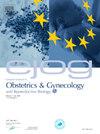用于预防妊娠期胎儿生长受限的四硝酸五苯酯(PETN):系统回顾和荟萃分析
IF 1.5
Q3 OBSTETRICS & GYNECOLOGY
European Journal of Obstetrics and Gynecology and Reproductive Biology: X
Pub Date : 2024-10-28
DOI:10.1016/j.eurox.2024.100350
引用次数: 0
摘要
背景胎儿生长受限(FGR)通常是由于胎盘功能不全引起的,对围产儿的预后构成重大风险。本综述评估了季戊四醇四硝酸酯(PETN)(一种一氧化氮供体)在预防 FGR 方面的疗效。方法通过检索 PubMed、Embase 和 CENTRAL(截至 2024 年 7 月)进行了系统综述和荟萃分析。纳入标准主要是比较 PETN 和安慰剂在预防 FGR 方面的作用的随机对照试验。主要结果包括FGR发生率、围产期死亡率、新生儿死亡率和宫内胎儿死亡(IUFD)。其他结果分为孕产妇、胎儿、新生儿和安全结果。我们使用 Cochrane RoB 2.0 工具评估偏倚风险,并使用 GRADE 标准评估证据质量。与安慰剂相比,PETN并未明显降低FGR的发生率(RR 0.83,95 % CI 0.66-1.04,2项试验,417名参与者,低确定性)或围产期死亡率(RR 0.64,95 % CI 0.26-1.58,2项试验,417名参与者,极低确定性)。没有一项研究报告了新生儿死亡率或 IUFD。不过,PETN 治疗与早产的减少有关(RR 0.74,95 % CI 0.58-0.93,2 项试验,417 名参与者,中等确定性)。结论虽然 PETN 对胎儿畸形率或围产期死亡率没有显著影响,但它与早产的减少有关,表明它对高危妊娠有潜在益处。有必要进行更大规模的试验来证实这些发现,并明确 PETN 在预防 FGR 中的作用。本文章由计算机程序翻译,如有差异,请以英文原文为准。
Pentaerithrityl tetranitrate (PETN) for prevention of fetal growth restriction in pregnancy: A systematic review and meta-analysis
Background
Fetal Growth Restriction (FGR), often due to placental insufficiency, poses significant risks to perinatal outcomes. This review evaluates the efficacy of pentaerythritol tetranitrate (PETN), a nitric oxide donor, in preventing FGR.
Methods
A systematic review and meta-analysis was conducted by searching PubMed, Embase, and CENTRAL up to July 2024. The inclusion criteria focused on randomized controlled trials comparing PETN to placebo in FGR prevention. Key outcomes were incidences of FGR, perinatal mortality, neonatal mortality, and intrauterine fetal demise (IUFD). Other outcomes were classified as maternal, fetal, neonatal and safety outcomes. We used Cochrane RoB 2.0 tool to assess risk of bias, and GRADE criteria for evidence quality.
Results
Two eligible studies encompassing 417 pregnant women at risk of FGR were included. PETN did not significantly reduce incidence of FGR (RR 0.83, 95 % CI 0.66–1.04, 2 trials, 417 participants, low certainty) or perinatal mortality (RR 0.64, 95 % CI 0.26–1.58, 2 trials, 417 participants, very low certainty) compared to placebo. None of the studies reported neonatal mortality or IUFD. However, PETN treatment was associated with a reduction in preterm birth (RR 0.74, 95 % CI 0.58–0.93, 2 trials, 417 participants, moderate certainty). Other outcomes were similar between the groups.
Conclusion
While PETN does not significantly impact FGR rates or perinatal mortality, it is associated with a reduction in preterm birth, suggesting potential benefits in high-risk pregnancies. Larger trials are necessary to substantiate these findings and clarify the role of PETN in FGR prevention.
求助全文
通过发布文献求助,成功后即可免费获取论文全文。
去求助
来源期刊

European Journal of Obstetrics and Gynecology and Reproductive Biology: X
Medicine-Obstetrics and Gynecology
CiteScore
2.20
自引率
0.00%
发文量
31
审稿时长
58 days
 求助内容:
求助内容: 应助结果提醒方式:
应助结果提醒方式:


